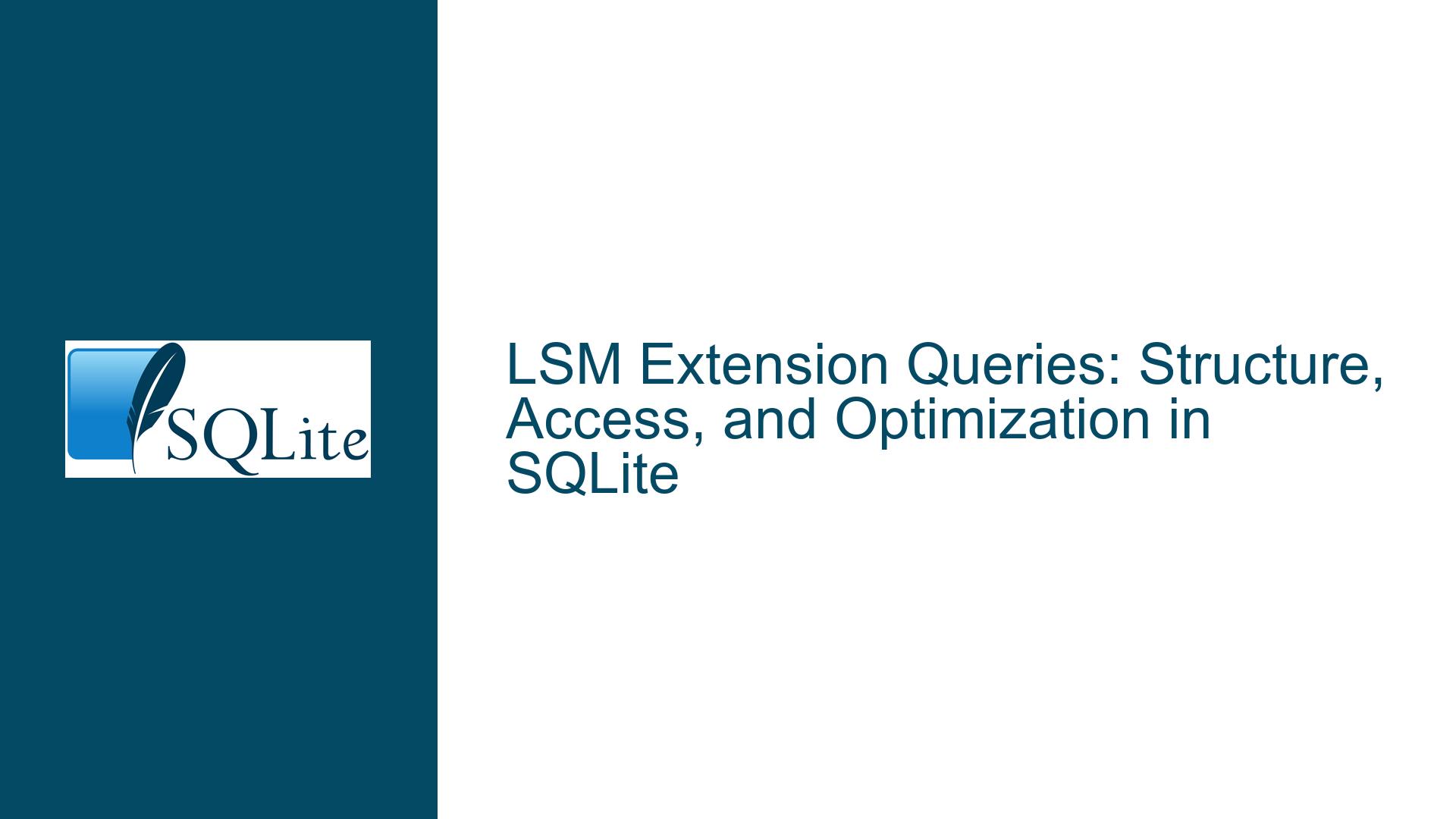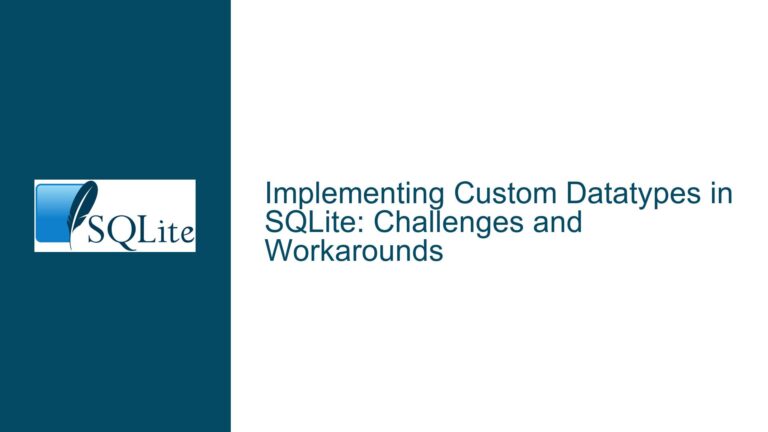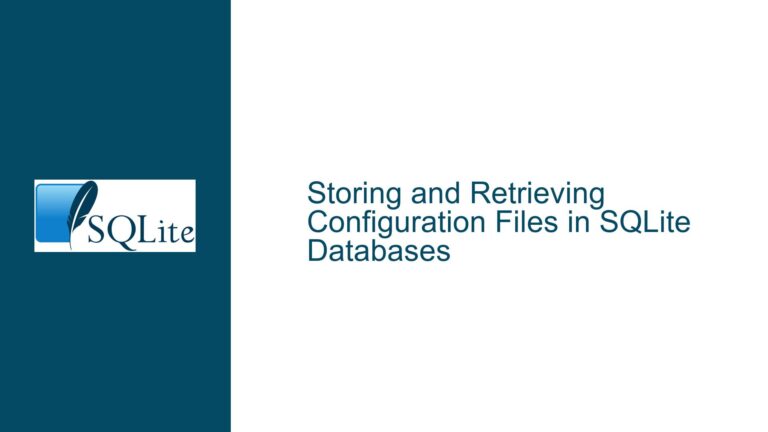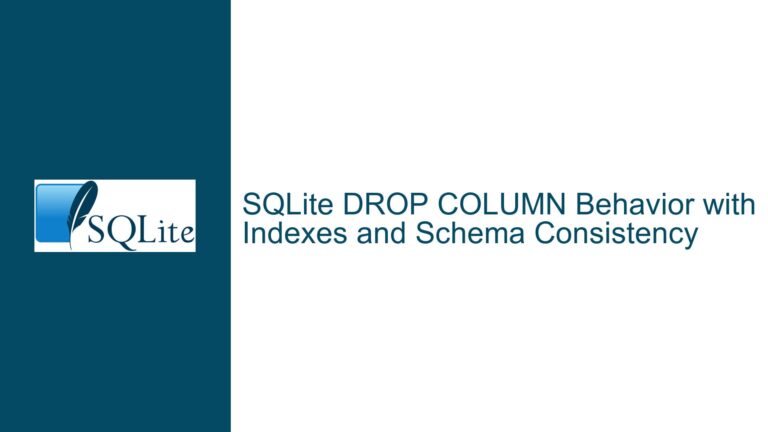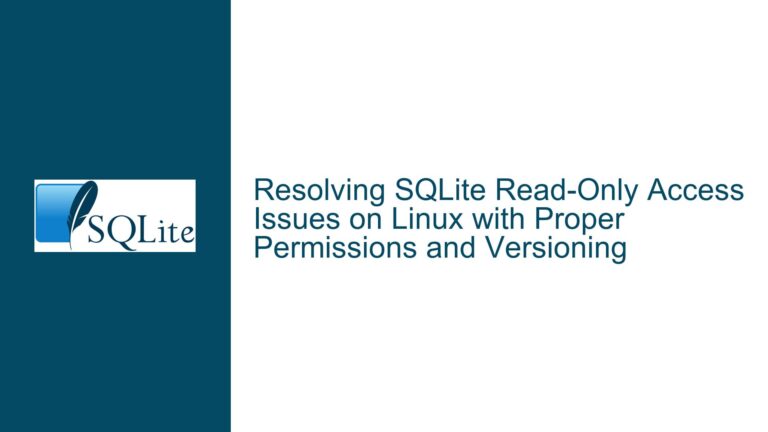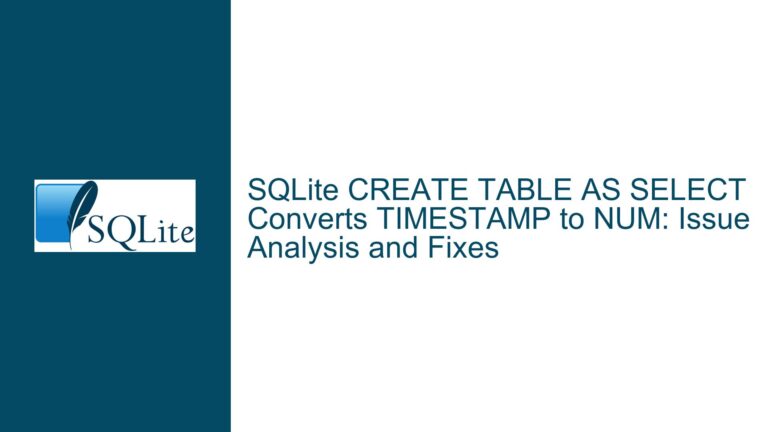LSM Extension Queries: Structure, Access, and Optimization in SQLite
Understanding LSM Extension Architecture, Key-Value Access, and Performance Constraints
The LSM (Log-Structured Merge-tree) extension in SQLite has been a topic of interest for developers seeking alternative storage engines or optimized key-value workflows. This guide addresses the core questions surrounding its file structure, data access patterns, maintenance operations, and performance optimizations. The discussion revolves around four primary areas:
- The undocumented nature of LSM file structures and their divergence from traditional SQLite database formats.
- Methods for database maintenance (compaction, defragmentation, integrity checks) in SQLite environments.
- Direct key-value access without SQL overhead.
- Partial value updates and memory efficiency concerns.
- Cross-platform compatibility (32-bit vs. 64-bit) and memory-mapped I/O limitations.
These issues are interconnected through SQLite’s design philosophy, which prioritizes reliability and simplicity over niche optimizations. The LSM extension, originally part of the abandoned SQLite4 project, introduces a key-value storage layer but lacks full integration with SQLite’s core relational model. This disconnect creates challenges for developers expecting native support for low-level operations like partial writes or direct key-value APIs.
Root Causes: Discontinued Development, Relational Model Constraints, and Storage Engine Limitations
1. Discontinued SQLite4 and LSM’s Experimental Status
The LSM extension was a cornerstone of SQLite4, an experimental branch discontinued due to insufficient performance gains for typical SQLite workloads. Unlike SQLite3’s B-tree-based storage, LSM uses a log-structured merge-tree optimized for write-heavy scenarios. However, its abandonment means:
- Undocumented File Structures: LSM’s on-disk format lacks public specifications, as it was never finalized.
- Limited Tooling: Built-in utilities like
sqlite3_analyzerorVACUUMare designed for SQLite3’s B-tree, not LSM’s segment-based architecture. - Unmaintained Codebase: The LSM1 extension, though available, is not actively developed, leading to compatibility risks with newer SQLite versions.
2. Relational Model vs. Key-Value Semantics
SQLite is fundamentally a relational database engine. Even when using LSM, all data operations require SQL statements. This design choice ensures transactional integrity and schema enforcement but introduces overhead for developers seeking pure key-value semantics. For example:
- Prepared Statements: While reusable after initial SQL parsing, they still require SQL text during preparation.
- Blob Interface: The
sqlite3_blobAPI allows direct byte access to BLOB columns but mandates a predefined schema and transactional context.
3. LSM Storage Engine Constraints
LSM’s immutable segment structure prevents in-place updates. When a value is modified, the entire key-value pair is written to a new segment. This approach optimizes write throughput but complicates partial updates:
- No Partial Writes: The
lsm_insertAPI overwrites the entire value, as merging partial updates across segments would require complex read-modify-write logic. - Compaction Overhead: Background compaction merges segments to reclaim space, but this process is opaque and non-configurable in SQLite’s LSM implementation.
4. Platform-Specific Memory Mapping Limitations
SQLite’s memory-mapped I/O (mmap) bypasses the page cache for direct disk access. However:
- 32-bit Address Space: On 32-bit systems, the maximum mappable file size is ~3 GB (with
/LARGEADDRESSAWAREon Windows). Larger databases require chunked mapping or fallback to standard I/O. - 64-bit Advantages: 64-bit systems support terabyte-sized mappings, enabling efficient access to large LSM databases.
Resolving LSM Challenges: Workarounds, Best Practices, and Alternative Approaches
1. Mitigating LSM File Structure and Maintenance Gaps
A. Compaction and Defragmentation
Since LSM lacks a native VACUUM command, manual compaction can be triggered by:
Database Restructuring:
-- Create a new table with the same schema CREATE TABLE new_data AS SELECT * FROM kv_store; -- Drop the original table DROP TABLE kv_store; -- Rename the new table ALTER TABLE new_data RENAME TO kv_store;This forces LSM to rebuild segments, discarding obsolete entries.
Configuration Tuning:
Adjust LSM’s merge policy to prioritize segment consolidation:lsm_config(lsm_db*, LSM_CONFIG_AUTOFLUSH, 4096); // Flush after 4KB of writes lsm_config(lsm_db*, LSM_CONFIG_AUTOCHECKPOINT, 8); // Checkpoint every 8MBSmaller autoflush values reduce segment fragmentation but increase write amplification.
B. Integrity Checks
Use SQLite’s PRAGMA integrity_check to verify database consistency. While not LSM-specific, it detects corruption in the SQL layer (e.g., index mismatches). For low-level LSM checks:
- Enable debugging logs via
lsm_config(lsm_db*, LSM_CONFIG_LOG, xLogCallback). - Implement a checksum validator during compaction callbacks.
2. Bridging SQL and Key-Value Workflows
A. Efficient Key-Value Access via Prepared Statements
Minimize SQL overhead by reusing prepared statements:
sqlite3_stmt *stmt;
sqlite3_prepare_v2(db, "INSERT INTO kv (key, value) VALUES (?, ?)", -1, &stmt, NULL);
for (...) {
sqlite3_bind_blob(stmt, 1, key, key_len, SQLITE_STATIC);
sqlite3_bind_blob(stmt, 2, value, value_len, SQLITE_STATIC);
sqlite3_step(stmt);
sqlite3_reset(stmt);
}
This reduces parsing overhead to a single invocation.
B. Direct Blob Access
For read-only scenarios, use sqlite3_blob_open to retrieve values without SQL:
sqlite3_blob *blob;
sqlite3_blob_open(db, "main", "kv", "value", rowid, 0, &blob);
sqlite3_blob_read(blob, buffer, buffer_len, 0);
sqlite3_blob_close(blob);
C. Virtual Table Wrapper
Create a virtual table interface for LSM, exposing key-value operations as SQL functions:
CREATE VIRTUAL TABLE kv_lsm USING lsm1(filename);
SELECT value FROM kv_lsm WHERE key = 'my_key';
3. Partial Value Updates and Memory Efficiency
A. Application-Layer Value Reconstruction
To avoid rewriting entire values:
- Read the existing value into a buffer.
- Modify the desired byte range.
- Write the updated buffer back.
// Fetch existing value
lsm_csr *csr;
lsm_csr_open(db, &csr);
lsm_csr_seek(csr, key, key_len, LSM_SEEK_EQ);
const void *old_val;
int old_len;
lsm_csr_value(csr, &old_val, &old_len);
// Modify substring
char new_val[old_len];
memcpy(new_val, old_val, old_len);
memset(new_val + offset, new_data, new_data_len);
// Write back
lsm_insert(db, key, key_len, new_val, old_len);
B. Leveraging SQLite’s Page Reuse Optimization
When updating a value to the same size, SQLite may reuse the existing B-tree page (not LSM segment). Ensure values are fixed-length or padded:
CREATE TABLE kv (
key BLOB PRIMARY KEY,
value BLOB CHECK(length(value) = 1024)
);
4. Cross-Platform Deployment Strategies
A. 32-bit Memory Mapping Workarounds
On 32-bit Windows with /LARGEADDRESSAWARE:
- Use multiple memory-mapped regions via
lsm_config(lsm_db*, LSM_CONFIG_MMAP, chunk_size). - Set
chunk_sizeto 1 GB and cycle mappings as needed.
B. 64-bit Optimization
Enable large address space and memory mapping:
lsm_config(lsm_db*, LSM_CONFIG_MMAP, 1); // Enable mmap
lsm_config(lsm_db*, LSM_CONFIG_MMAP_SIZE, 1UL << 30); // 1GB mapping
5. Alternatives to Native LSM Integration
A. LMDB (Lightning Memory-Mapped Database)
For in-place updates and zero-copy reads, consider LMDB as a separate key-value store:
- Partial Writes: Use
mdb_putwithMDB_RESERVEto modify values in-place. - Transactions: ACID-compliant with single-writer/multiple-reader concurrency.
B. SQLite’s RBU Extension
The Remote Bulk Update (RBU) extension enables batch key-value updates with minimal SQL overhead:
-- Attach RBU database
ATTACH 'rbu.db' AS rbu;
-- Apply bulk updates
SELECT rbu_apply('rbu.db');
By addressing these areas systematically, developers can mitigate the limitations of SQLite’s LSM extension while adhering to its relational foundations. The solutions emphasize leveraging SQLite’s existing APIs creatively, understanding storage engine trade-offs, and adopting hybrid architectures where necessary.
